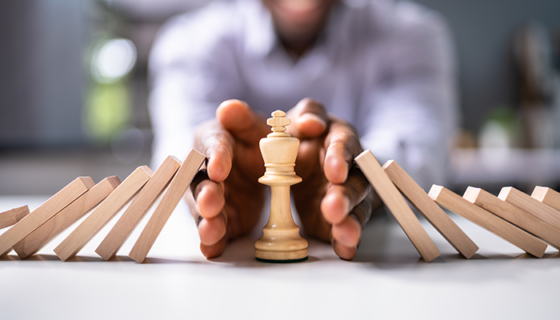Move your Organization from Wait-and-See to a Chance-to-Lead

Whether it is thanks to the coronavirus pandemic or accelerated exponential change that has been taking place for decades prior, digital disruptions are not slowing down anytime soon. And while the wave of change is bringing new opportunities all the time, it is bound to create discomfort for those who believe they are immune to change.
I coin this mentality the "wait-and-see mindset": when a business or organization decides to wait out a massive digital disruption that is either heading its way or is already shaking up the products or services it offers. Realistically, we all wait and see in some ways -- it is certainly easier to let someone take the leap and, theoretically, get banged up on the way down, showing you what not to do.
However, seldom does that turn out the way a business leader, entrepreneur, or employee was hoping, largely because that same leap will never be there for you to take again, or even worse, you could be left stranded where you are at.
But the good news is that because of how accelerated digital disruptions have become, there is likely more than just one opportunity to leverage in your industry. Therefore, if you recognize that your organization has a wait-and-see mindset around the discomfort of change, here is your chance to transform that for the better.
To Wait-and-See Is Wishful Thinking
First and foremost, let's understand this wait-and-see mindset a bit more to help you get more comfortable with letting go of relying on it so heavily.
In past blogs, I have addressed this mindset; however, I want to remind everyone of a fact of life: Everyone has a wait-and-see mindset initially! That's right, even the riskiest individuals first consider waiting out something they are unsure about. This is a primordial survival trait, similar to our aversions to change.
Finding a status quo means safety for us. Just like animals have instincts that, even after domestication, they cannot shake, human beings strive for a "normal" of sorts. It is why the pandemic has been so disruptive to many people's mental health; living like we have is so far from what we have deemed normal for centuries.
In business, protecting and defending your status quo is necessary in some ways. What you've built is working, and so long as your business or organization is making money, you are able to pay employees and keep the ball rolling. But getting too set in your ways, such as relying on what I've referred to as your cash cow that accounts for most of your income, puts you at risk for complete disruption.
Take, for example, the global supply chain. Truck drivers and delivery personnel are integral to keeping the supply chain moving smoothly, especially since so many individuals shop online these days. However, what about the boom in autonomous vehicles and drone delivery services? What does that do to trucking companies and third-party delivery services? Sitting and hoping that these technologies won't affect your company or arrogantly boasting that "this will never be widely accepted" is wishful thinking -- they are here to stay.
Change Is Always Coming
It is foolish to think that changes in business have a universal "end" to them.
Change will always happen so long as individual customers discover new problems with their current processes. Decades ago, the leaders at Amazon realized they would one day not be the best online bookstore alone, just as leaders at Google recognized that a search engine could not stay in the lead forever.
But what type of change impacts your business or industry? As I've taught in my Anticipatory Leader System, there are two different types of change: cyclical and linear change. Cyclical change happens over and over again -- an extremely predictable transformation that you can leverage to your advantage. Taking our supply chain example from earlier, the holiday season and all its deliveries are cyclical, as every year, people will order more around this time, needing delivery in one way or another.
Linear change is different; it happens once and doesn't happen again, but when it does occur, it is massively disruptive. For truck drivers, delivery personnel, and the global supply chain, autonomous vehicles and remote-controlled delivery via drones are here to stay and will only further uproot legacy systems.
At the time of this writing, fully autonomous semi-trucks are not yet largely used, nor is drone delivery the go-to solution. That means that businesses involved in the global supply chain still have time to leverage these disruptions to their benefit instead of waiting these changes out, but how?
Taking Anticipatory Action Now
I focus a good portion of my Anticipatory teachings toward business leaders within organizations, but for this example, let's consider the workers affected by a wait-and-see mindset in the global supply chain industry.
Even if you are a manager or higher-level executive reading this, it is imperative to note that your employees are your lifeblood and that your organization is theirs. You are a team, and teammates look out for one another. A wait-and-see mindset is costly for all involved.
With that being said, the Hard Trends shaping the global supply chain industry can be leveraged by leaders to benefit both themselves and, perhaps more importantly in this case, their employees. With drone delivery being on the rise, offering delivery drivers the opportunity to get their drone licenses prepares them for this potential shift in the industry.
In turn, your proactivity will restore their faith in the progression of your organization. Not only will they feel prepared to stay employed in the industry, but they will also feel reassured that you are taking steps to help them continue to work for you.
Remember, there is a risky cost associated with a wait-and-see mindset and, even worse, saying no to disruptions. If these businesses in the global supply chain industry decide against preparing for a remote-controlled or autonomous shift in delivery, they not only will lose employees but, ultimately, will lose the clientele that keeps them in business.









